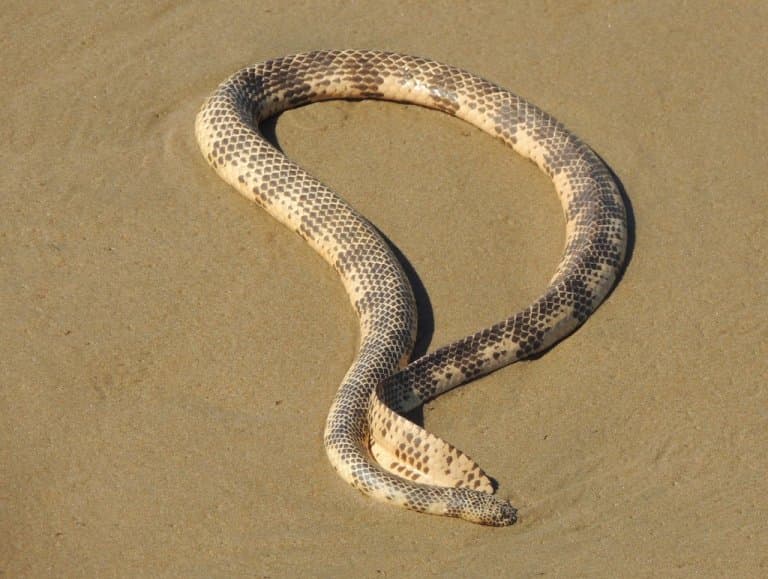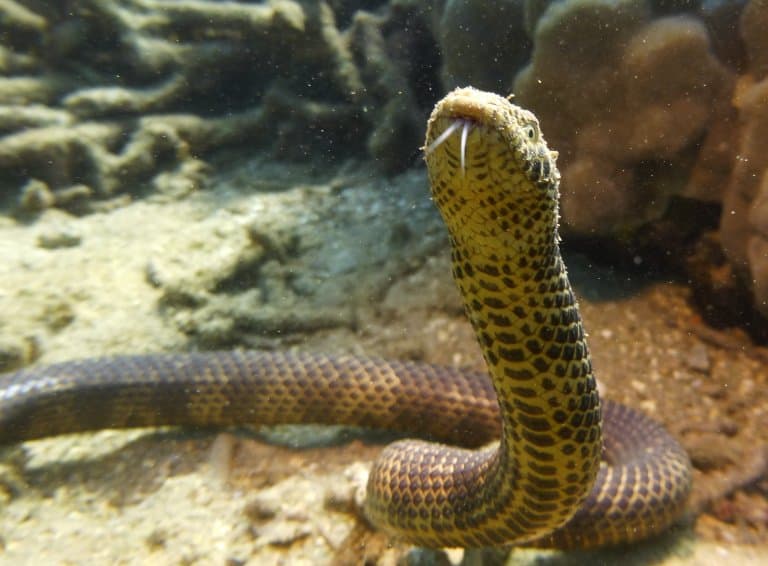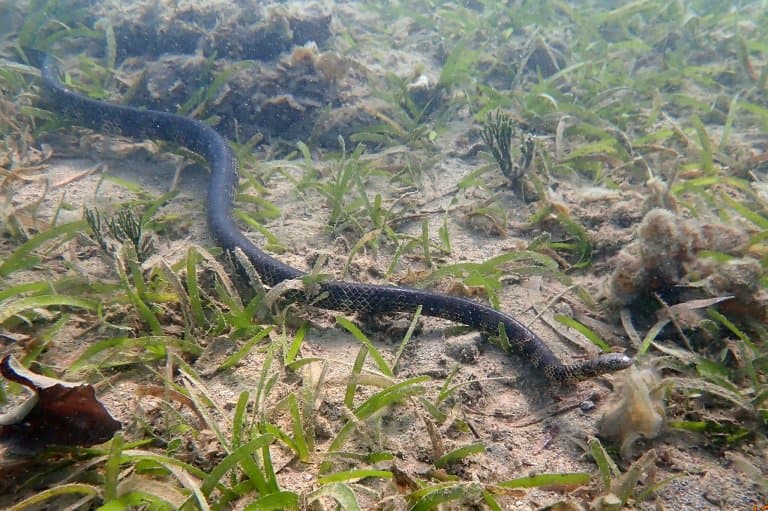Dubois’ Sea Snake Profile
It’s easy to think that Australia has the most venomous animals of any country, but this isn’t entirely true. Mexico has about 30% more venomous species recorded, and Brazil has only one species less than Mexico.
What Australia does have, however, is a fine selection of some of the deadliest venomous animals. These are the ones that will leave more than a little swelling under the skin, and they’re found all over the land, in the rivers, and in the ocean, too.
One of them, the innocuously-named ‘reef shallows sea snake’, or Dubois’ sea snake, is the second most venomous snake in the world tested (after two more Australian species)!

Dubois’ Sea Snake Facts Overview
| Habitat: | Coral reef, marine |
| Location: | Northern coast, from East to Western Australia, Papua New Guinea |
| Lifespan: | Just less than 9 years |
| Size: | Up to 1.5m (5ft) long |
| Weight: | Unknown |
| Colour: | Variable, from black to light brown |
| Diet: | Generalist predators, moray eels, fish |
| Predators: | None |
| Top Speed: | Unknown |
| No. of Species: | 1 |
| Conservation Status: | Least Concern (But very out of date, IUCN) |
This is one of the Elapids, snakes known for their highly venomous approach to life. And it doesn’t disappoint! Thankfully, they’re not only remote – living their entire lives in the ocean – they’re docile and under-equipped to cause much harm to humans.
They live at depths of up to 80m (262 ft) in coral reef flats and sand, which it can use as shelter and for hunting prey.
It diets on fish and moray eels, as well as small invertebrates that live on the ocean floor. In general, the Dubois’ sea snake has a chilled nature, but it will attack if provoked.
Instead of being feared, they should be respected as highly-adapted, true sea snakes that have earned their spot in the reef ecosystems of Northern Australia.
Interesting Dubois’ Sea Snake Facts
1. They’re equipped for the ocean
Many species of snake are strong swimmers and very comfortable in the water, but a real aquatic snake gives itself away with a series of special adaptations to its environment.
Firstly, the end of the tail is flattened and paddle-like, for obvious reasons. Then, the nostrils are usually higher up on the top (dorsal) surface of the head and can be held shut from the inside.
They can even breathe through the skin if there’s enough oxygen in the water, and they can excrete and spit salt, as many marine vertebrates need to, to avoid it building up to dangerous levels in their body from the food they eat.
One other way to tell it’s a sea snake is to cover its nose with your fingers and see if it panics. This one can hold its breath for up to two hours, so wouldn’t worry about it too much, though we recommend against trying this method, as there are certain risks involved. 1
2. They’re quite venomous
This snake has the most toxic venom of any sea snake recorded. Researchers understand this because they spent various grants on labs full of rabbits and mice to inject the venom into.
Dialling the dose down until they only kill half of their subjects, they’re able to identify a metric of lethality called the LD50 – the amount of venom it takes to establish a 50% of death.
These ethically questionable experiments lead us to understand how venoms work, and, in particular, how they work on various types of animals.
Rabbits are twice as sensitive to this snake’s venom than mice, despite neither really spending a lot of time in the reef. Fish and frogs, perhaps unsurprisingly, are the most susceptible.
Mice are usually correlated most closely to humans in terms of LD50, and in mice, this snake’s venom was established to have a lethality of 0.044mg/kg, equating to around 3.3mg in a 75kg human. 2
3. But there’s more to lethality than toxicity
There are so many factors that go into the lethality of an animal’s venom. The LD50 is all well and good, but what if its venom sacks only contain 1mg of the venom at a time?
Or what if its teeth are too small to pierce the skin? Some snakes even give what’s known as a “dry bite” in order to scare off a threat without wasting any of the precious venom it needs to kill food.
There’s also the element of access. It’s not easy to accidentally step on a snake if it’s swimming in water the whole time, and people don’t typically spend as much time in the ocean as they do on land.
Then, access to antivenom dramatically shifts the likelihood of someone dying from a bite. Finally, there’s the attitude of the animal itself. Some snakes just don’t want to bite you. 3

4. So, it doesn’t seem to have killed anybody, yet
Despite being the most toxic sea snake, and the second most toxic snake overall, many of these factors combine to make it essentially harmless in most cases. In Australia, there’s been only one fatality from (an unspecified) sea snake bite since the ‘30s, and only a handful likely, ever.
While the Dubois’ sea snake can potentially inject enough venom to kill a particularly small and unlucky person, cases simply aren’t available in the literature to suggest that it ever does, and bites from sea snakes in general really only occur when fishermen are bringing up nets that have entangled one of them.
The Dubois’ fangs are less than 2mm long, and its venom yield is typically 0.43mg, far beneath the LD50 for most people (For reference, the taipan, the most toxic snake, can deliver well over 100mg in an average bite, up to a max of 400mg, and there aren’t even any confirmed lethal bites from this species either).
This is likely why it appears there’s no confirmed account of a lethal bite from this species. They’re just not interested in it. Unless, of course, you’re an eel. 4
5. They’re eel-eaters
While this snake is not considered dangerous to humans (outside of some fear-mongering, uncited publications), the same risk assessment cannot be concluded for moray eels.
This is a fish-eating snake, and one of its favourite foods is the great Moray eel.
Morays are generally immune to a lot of the destructive influences that fishing has on reefs, and so are abundant in the habitat of the Dubois’ snake.
However, they’re no push-over and have powerful, extendible jaws and strong muscular bodies. They’re also often quite large prey for a snake this size, all of which goes to show why the Dubois’ evolved to have such powerful neurotoxic venom in the first place. 5

6. They give birth to live young
One final thing that’s worth reiterating, is that these are true sea snakes. That means they have thoroughly embraced life at sea and never bother to come to land.
While this snake’s ancestors were land-dwelling, these species have very little in common with their terrestrial cousins, and really only share the need to breathe air.
As such, they can live most of their lives as deep as 80 meters down on the reef, and all their systems have to operate in the submarine environment. They’re so at home in the ocean that they’re often encrusted with algae and polychaete worms.
This includes giving birth. As eggs may not get the warmth they need to incubate in the water, sea snakes have generally evolved to give birth to live snakelets. This is the case in the Dubois’, which releases a litter of around 4 to 5 mini versions of herself.
Dubois’ Sea Snake Fact-File Summary
Scientific Classification
| Kingdom: | Animalia |
| Phylum: | Chordata |
| Class: | Reptilia |
| Order: | Squamata |
| Family: | Elapidae |
| Genus: | Aipysurus |
| Species: | Aipysurus Duboisii |
Fact Sources & References
- “Aipysurus duboisii — Dubois’ Seasnake”, Environment.gov.org.
- “Most venomous land snake”, Guinness World Records.
- Shijie Zhou (2012), “Integrated risk analysis for rare marine species impacted by fishing: sustainability assessment and population trend modelling”, Oxford Academic.
- Vinay Udyawer (2021), “Peaceful coexistence between people and deadly wildlife: Why are recreational users of the ocean so rarely bitten by sea snakes?”, British Ecological Society.
- “Reef Shallows Seasnake”, iNaturalistNZ.
